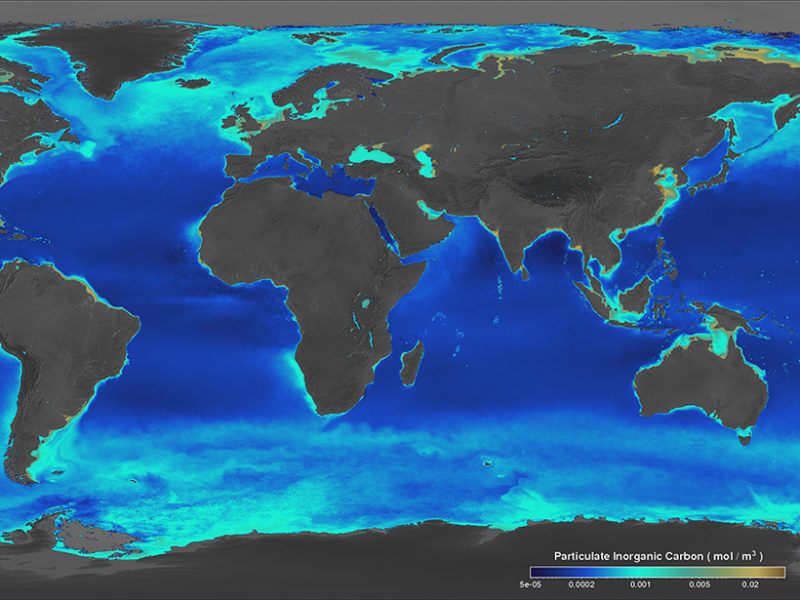MIT, News, WHOI | January 27, 2017
Tiny Creatures Form Massive, Bright Ring Around Antarctica
Dense algae populations in the Great Calcite Belt could cause carbon dioxide release from the ocean into the atmosphere.

By Sarah Stanley, Freelance Writer
Every year during the austral summer, satellite imagery reveals a wide belt of unusually reflective seawater encircling Antarctica between about 38°S and 60°S. This bright, patchy halo, known as the Great Calcite Belt (GCB), covers 16% of the entire global ocean. New research by Balch et al. identifies key factors behind the formation of the GCB and explores its effects on carbon cycling.
The team ventured into the GCB aboard the R/V Melville in 2011, sailing between the Patagonian Shelf off the coast of Argentina to Cape Town, South Africa. One year later, they sailed the R/V Revelle from Durban, South Africa, to Freemantle, Australia. On both trips, the scientists measured backscattering of light from the surface ocean and collected water samples to measure microbial activity.

The scientists combined their ship data with satellite imagery to confirm that dense populations of single-celled phytoplankton known as coccolithophores are responsible for the GCB. These tiny plants are covered with scales made out of calcium carbonate, which is also known as particulate inorganic carbon (PIC). PIC is what makes the GCB so reflective.
Nutrients that affect coccolithophore growth drive the formation of the GCB, the researchers found. Lower iron levels in the Indian Ocean region of the GCB may explain why the feature is less lustrous there, and a lack of other nutrients and competition with other plants may be why the GCB doesn’t extend farther north or south. The researchers found more PIC in areas with greater current speed, suggesting that upwelling of nutrients from the deep ocean may promote coccolithophore growth in the GCB.
The researchers also found that coccolithophore-rich regions of the GCB release carbon dioxide into the atmosphere. Coccolithophores show a net release of carbon dioxide into seawater during shell formation and plant growth, whereas another common phytoplankton group in the Southern Ocean (diatoms) acts as strong sinks for carbon dioxide during photosynthesis. The scientists found that this balance seems to shift at high coccolithophore concentrations, and enough carbon dioxide gas builds up that it escapes into the atmosphere.
Coccolithophores may be most noticeable in the GCB, but they are found in seawater worldwide and play an important, if complex, role in the carbon cycle. Ocean acidification could reduce their ability to form calcium carbonate shells and impact their effects on atmospheric carbon dioxide. (Global Biogeochemical Cycles, doi:10.1002/2016GB005414, 2016)
© 2017. The authors. CC BY-NC-ND 3.0






